Conservation Science
Protecting Pennsylvania’s Plants and Animals
Energy Development
It is estimated that before the arrival of Europeans, Pennsylvania’s landscape consisted of more than 95% forests. Today, only 59% of those forests remain with much of it broken into smaller pieces by highways, urban areas, industrial sites and non-forested lands. Pennsylvania’s landscape continues to change and be altered by development of all kinds. Some of these development pressures are recent and present new challenges to keeping the state’s remaining forests as intact, our water as clean as possible and our native species protected. The Western Pennsylvania Conservancy is involved in several efforts to monitor the impacts of energy development in the region.
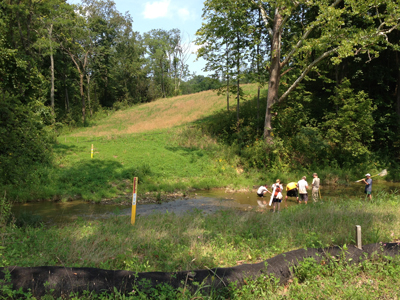

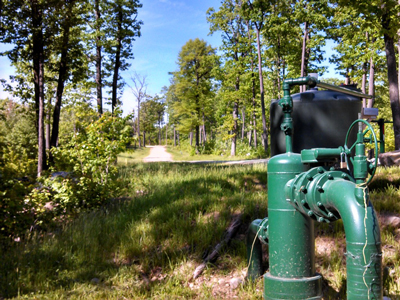
While the mining of coal has declined to an extent, shale gas and wind power development have dotted the landscape with new infrastructure. Often, these developments are within forested landscapes. In addition to directly removing forest habitat, the new roads, pipelines, well pads and wind mill locations act to divide or fragment forests. Reducing the size and connection of contiguous forests reduces their quality and viability. It becomes more difficult to conserve and manage the smaller patches of forest and more difficult for forest flora and fauna to survive.
The increasing demand for energy to power our society and the technological advancements that enable us to develop new forms of energy continue to put pressure on our wildlife, fish and wildlife species and rural communities. In 2010, WPC scientists collaborated with The Nature Conservancy and Audubon Pennsylvania to develop a Pennsylvania Energy Impacts Assessment, which models the potential impacts of Marcellus Shale natural gas and wind development in Pennsylvania.
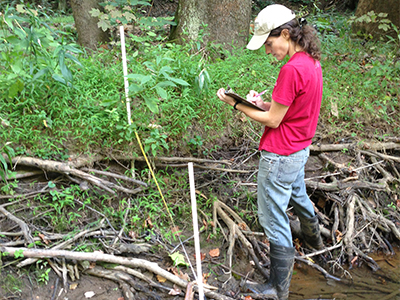
Shale Gas Development
The impact of shale gas development can be seen within the landscape and on the species of our region. More than 45% of Pennsylvania’s Natural Heritage Areas in county Natural Heritage Inventories, which are assessed and managed by the Pennsylvania Natural Heritage Program, are underlain by the primary targets for deep gas extraction, the Utica and Marcellus shale formations.
Further analysis of our data shows that 724 rare species tracked by PNHP and approximately 62% of all species occurrences in the state are found within the combined Marcellus and Utica regions. Nearly 350 of these species have more than 70% of their occurrences in the shale gas region.
While determining shale gas impacts on a specific species or group of species is more complicated than just overlaying site locations, core habitats and threats, these numbers suggest that a substantial proportion of rare plant and animal species could be affected by the development of shale gas in Pennsylvania. Species of isolated habitats and those requiring specific habitat resources may be most threatened.
Round 1 Assessment – 2013-2015
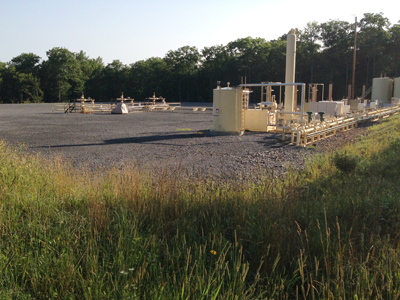
In 2013, thanks to the generosity of the Richard King Mellon Foundation and other private funders, the Conservancy launched a baseline ecological assessment of areas of high conservation value that would likely be impacted by activities associated with natural gas development and production.
Field biologists documented chemical and biological indicators of water quality and ecosystem health at 51 sampling points within 35 high-value ecological areas, referred to as focal areas. They also assessed the condition of 25 forest stands and the characteristics of bird communities, and conducted surveys for rare and important plant and wildlife species.
Round 2 Assessment – 2016-2017
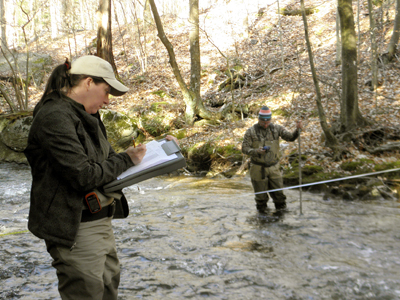
In 2016-2017, WPC returned to 15 of the 35 focal areas impacted in some way by development of unconventional natural gas. Aquatic monitoring included resampling of 25 of the original sampling points from 2013-2014, plus 15 additional locations, located closer to well pads.
Terrestrial monitoring activities included breeding bird point counts and a rapid assessment of habitat structure and composition in all 15 focal areas selected for survey in the second phase of this study. In each focal area, we assessed and referenced forest conditions in large patches of interior forest and sites adjacent to shale gas well pads.
The report on WPC’s second round of monitoring for shale gas impacts is available for download. Methods, research objectives and findings are included in this report. Explore the focal areas and learn more about the data collected at our monitoring sites. For more information on site-specific water quality data or ecological information from assessment and monitoring activities within the focal areas, please contact us at info@paconserve.org.

Pipeline Right-of-Ways
Pipelines and transmission right-of-ways can be significant barriers for some wildlife species. These right-of-ways represent breaks, often 100m wide, in the forest habitat and are often planted in non-native hay-field grasses with little-to-no habitat value to wildlife.
WPC is collaborating with PA DCNR to examine butterfly and moth populations at these sites. Butterflies and moths are a diverse group of insects that play an important role in the environment as plant herbivores, pollinators and food sources for larger predators. They can be used to assess the overall health and functioning of an ecosystem.
This study is looking at the impact of native plant habitat restoration at these sites in comparison to sites planted with traditional seed mixes. These traditional mixes often focus on soil stabilization and use quick-growing plants, many of which are non-native. WPC’s research will be used to evaluate planting guidelines and management techniques currently being employed on state lands. Improving these guidelines will have a positive impact on the ecosystem function and wildlife habitat value of right-of-ways so they may benefit native pollinators.
One study region is in northcentral Pennsylvania where native plants are being used to reclaim areas disturbed during the creation of natural gas infrastructure. A second study region is located in southcentral Pennsylvania where the Michaux State Forest District has begun implementing management recommendations to ensure the long-term integrity of a ridgetop barrens ecosystem that supports many unique kinds of birds, mammals, reptiles, plants and insects.
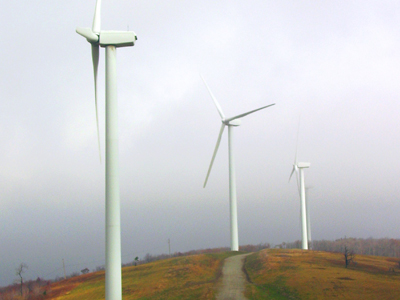
Wind, Solar, and other Alternative Forms of Energy
Energy production from wind, water and the sun is considered to be “greener” than energy produced from the burning of fossil fuels as these carbon-free energy sources do not contribute to climate change. However, improper siting of the energy infrastructure and facility management can still impact wildlife species through the effects of habitat fragmentation.
Improperly sited and managed wind infrastructure may result in direct mortality in some cases as birds and bats collide with turbine blades, guy wires and transmission lines. Working with partners, the Conservancy has studied the collective impacts of wind energy development in Pennsylvania into the coming decades. In partnership with PA DCNR and PA DEP, Conservancy biologists developed best management plans to limit impacts to invertebrate species and large forests patches.
Like wind energy, solar energy and hydroelectric power are considered alternative energy sources. However, new large-scale power generation plants are currently not much past the proposal stage. There will be direct and indirect impacts of these sources of energy, as well. The Conservancy will continue to follow development trends and will contribute information and expertise to guide the siting and management of these new energy sources.
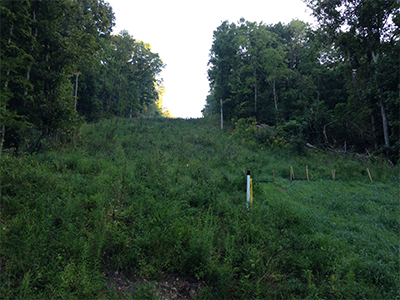
Forest Fragmentation
Fragmentation of contiguous forested landscapes into smaller, isolated tracts has an effect on plant and animal distribution and community composition. Large pieces of forest tracts are often fragmented by human development or split into pieces by transportation and utility corridors. This can result in what we call “forest islands,” which can lack some of the habitats that existed in the original tract or are smaller than the minimum area required by a given species.
For example, the Louisiana waterthrush (Seiurus motacilla) is rarely found in small woodlots because they require upland forests with streams within their territory and most small woodlots lack this necessary component. Area-sensitive species such as the northern goshawk (Accipiter gentilis), barred owl (Strix varia), bobcat (Lynx rufus) and timber rattlesnake (Crotalus horridus) require interior forest areas in excess of 6,000 acres to accommodate breeding and foraging territories.
New energy infrastructure development is expected to increase forest fragmentation impacts to forests and streams of Pennsylvania. Fragmentation impacts are very specific and have different effects in different landscapes. Different species react to fragmentation in different ways. WPC’s landscape assessment and planning work is conducted to assess change due to human development. These analyses provide valuable information to guide management activities that work to reduce the overall impacts of large-scale development activities.
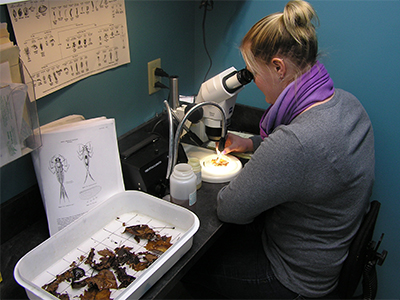
Water Quality
There are many threats to the quality of streams in Pennsylvania associated with agriculture, development and energy development. Not only does the extraction of shale gas require significant amounts of water, it also uses a cocktail of chemicals, produces significant waste and disturbs a substantial amount of soil and vegetation.
Other issues that can affect water quality include faulty septic systems, poorly maintained dirt and gravel roads, improper agricultural practices (leading to sedimentation and nitrification of streams) and historic activities such as coal mining, shallow gas extraction and industrial activity. WPC uses multiple methods to assess the current ecological conditions of our streams and works to obtain baseline aquatic assessment of surface waters across the commonwealth. These data are often used to assess the effectiveness of management and restoration activities.
